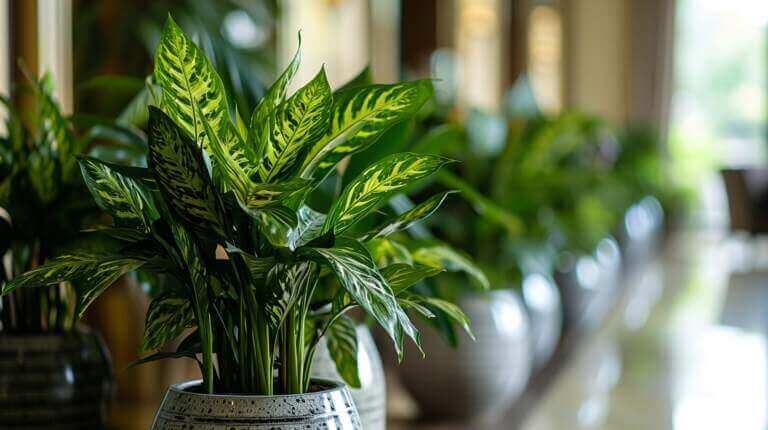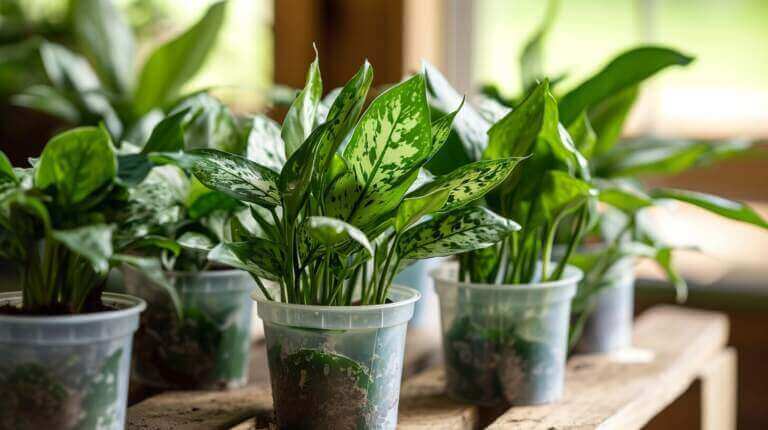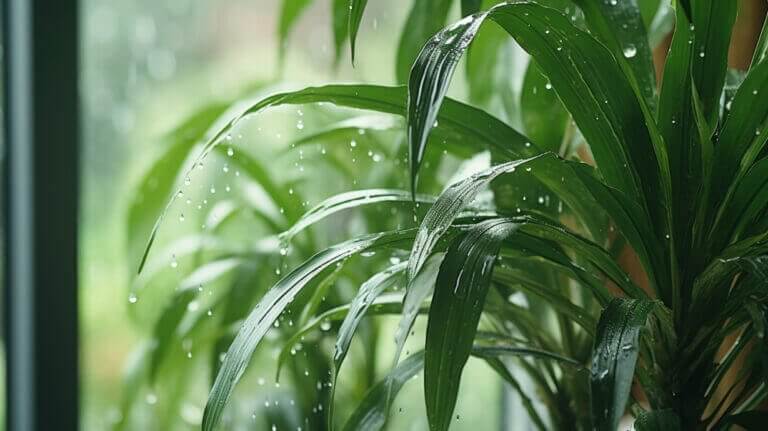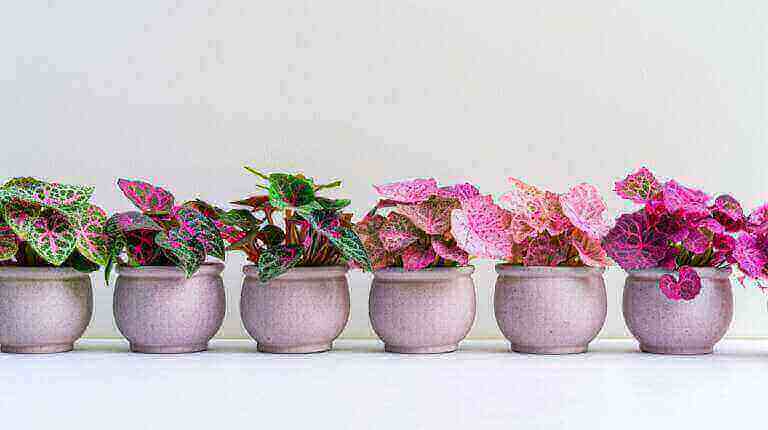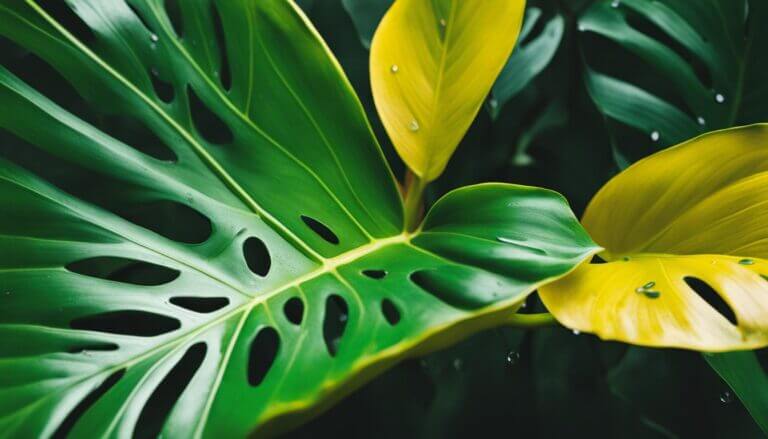Why Is My Indoor Elephant Ear Plant Dripping Water Droplets? Understanding Guttation
Have you ever noticed water droplets forming on the leaves of your elephant ear indoor plant? Don’t worry, it’s not a cause for concern. This phenomenon is called guttation, and it is a natural process that occurs in certain plants, including the elephant ear. Understanding guttation can help you better care for your alocasia plant and ensure its health and well-being.
Key Takeaways:
- Guttation is a natural process in certain plants, like the elephant ear, where excess water is excreted through the leaf tips.
- Guttation is caused by excess water in the plant’s cells, often resulting from overwatering or high humidity levels.
- Managing guttation involves adjusting the watering schedule, monitoring soil moisture, providing proper drainage, and maintaining optimal humidity levels.
- Common mistakes in elephant ear plant care include overwatering, which can lead to excessive guttation, yellowing leaves, and root rot.
- By understanding guttation and addressing common mistakes, you can ensure the health and well-being of your elephant ear plant.
What is Guttation and Why it Occurs in Indoor Elephant Ear Plants
Guttation is the process by which water droplets form on the leaves of a plant, usually from the elephant ear leaves edges or tips. These droplets of water are not the result of watering or rainfall, but rather the plant’s own internal processes. In the case of indoor elephant ear plants, guttation occurs due to a combination of factors.
One important factor is transpiration, the process by which plants lose water through small openings called stomata on their leaves. During the day, when the plant is actively photosynthesizing and transpiring, water vapor is released through these stomata. However, at night or in high humidity conditions, when the stomata are closed to conserve water, the excess moisture within the plant builds up and gets forced out through special structures called hydathodes. These hydathodes are tiny pores located at the edges of the leaves, and they are responsible for the release of water droplets during guttation.
It is important to note that guttation is a natural and normal process for indoor elephant ear plants. It is not a cause for concern unless it becomes excessive or if the droplets have an unusual color or odor, which could indicate a problem such as infection or overwatering.
| Causes of Guttation: | Effects |
|---|---|
| Excess water in plant cells due to overwatering | Increased guttation and risk of root rot |
| High humidity levels | Enhanced guttation as a natural response |
| Improper drainage | Increased guttation and potential waterlogging |
| Plant adaptation | Regular guttation to prevent waterlogging |
Understanding the causes of guttation in elephant ear plants is crucial for maintaining their health. By avoiding overwatering, ensuring proper drainage, and monitoring humidity levels, plant owners can create a suitable environment that minimizes excessive guttation and promotes optimal growth.
How to Manage Elephant Ear Plants Water Droplets?
To effectively manage guttation in elephant ear plants, it’s important to adjust the watering schedule and closely monitor the soil moisture levels. Here are some key steps to manage guttation and ensure the health of your plants:
1. Adjusting Watering Schedule:
One of the main causes of guttation is overwatering. To prevent excessive guttation, it’s crucial to adjust the watering schedule and provide the right amount of water for your elephant ear plants. Allow the soil to dry out slightly between waterings to avoid water saturation and ensure proper drainage.
2. Monitoring Soil Moisture:
Regularly monitor the moisture levels of the soil to maintain optimal conditions for your elephant ear plants. Insert your finger into the soil up to the second knuckle. If the soil feels moist, it’s a sign that you should wait before watering again. Only water when the soil feels slightly dry to the touch.
3. Providing Proper Drainage:
Proper drainage is essential for preventing waterlogging and excessive guttation. Ensure that the pot or container you use has drainage holes at the bottom to allow excess water to escape. You can also add a layer of gravel or small stones at the bottom of the pot to improve drainage.
4. Maintaining Optimal Humidity Levels:
Elephant ear plants thrive in tropical environments with high humidity. To help minimize guttation, maintain an optimal humidity level around your plants. You can increase humidity by misting the leaves with water or placing a humidity tray filled with water near the plant. Alternatively, you can use a humidifier to maintain consistent humidity levels.
By following these steps, you can effectively manage guttation in your elephant ear plants, ensuring their health and vitality. Remember to adjust the watering schedule, monitor soil moisture, provide proper drainage, and maintain optimal humidity levels for a thriving plant.
| Guttation Management Steps | Benefits |
|---|---|
| Adjust the watering schedule | Prevents overwatering and excessive guttation |
| Monitor soil moisture levels | Maintains optimal conditions for plant growth |
| Provide proper drainage | Prevents waterlogging and improves plant health |
| Maintain optimal humidity levels | Minimizes guttation and supports plant vitality |
Factors that contribute to elephant ear plant dripping water
Several factors contribute to the occurrence of guttation in indoor elephant ear plants. Understanding these factors can help plant owners better care for their plants and create optimal growing conditions.
Elephant Ear Plant Is Dripping(Transpiration rate)
The rate at which a plant transpires plays a significant role in guttation. When the transpiration rate is high, more water is drawn up from the roots and released through the leaves, increasing the chances of guttation occurring.
Elephant Ear Plant Is Dripping Water(Nighttime or high humidity conditions)
During the night or in high humidity conditions, the stomata on the leaves of indoor elephant ear plants close to conserve water. This closure results in the buildup of excess moisture within the plant, which is then forced out through the hydathodes during guttation.
Elephant Ear Plants To Drip Water(Adequate hydration)
Guttation is more likely to occur when a plant is adequately hydrated. If the plant’s water intake is sufficient, there will be excess moisture within the plant that can be released through guttation.
Water Dripping From Elephant Ear Plant(Leaf shape and structure)
The shape and structure of the leaves of indoor elephant ear plants also play a role in guttation. The presence of hydathodes at the edges of the leaves makes the plant more prone to guttation, as the excess water can easily be released through these structures.
FAQ
Why is my elephant ear dripping water?
The phenomenon of water dripping from the tips of elephant ear plant leaves is known as guttation, which is a natural process of excreting excess water. It is a healthy and normal adaptation of the plant.
What causes guttation in elephant ear plants?
Guttation in elephant ear plants is mainly caused by excess water in their cells, which can result from overwatering or high humidity levels. When the soil is saturated, the roots absorb more water than the plant needs, leading to the expulsion of excess moisture through the leaf margins.
How can I manage guttation in elephant ear plants?
To manage guttation, adjust the watering schedule to provide the right amount of water. Allow the soil to dry out between waterings, monitor soil moisture levels, use well-draining potting mix, and maintain optimal humidity levels around the plant.
What are common mistakes and FAQs about elephant ear guttation?
Common mistakes in elephant ear plant care include overwatering, which can lead to excessive guttation, yellowing leaves, and root rot. FAQs include concerns about plant health, preventing overwatering, and the frequency of watering.


